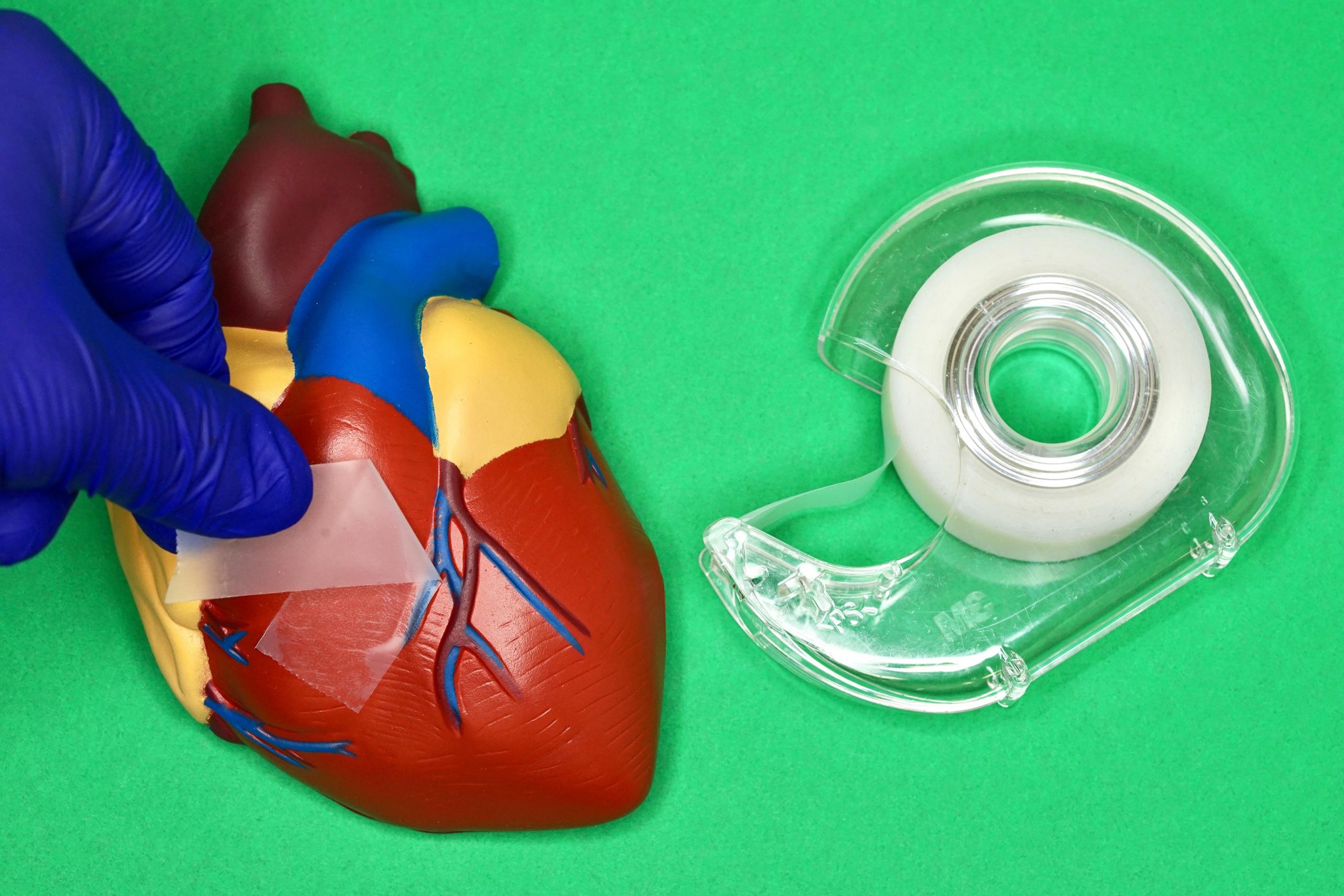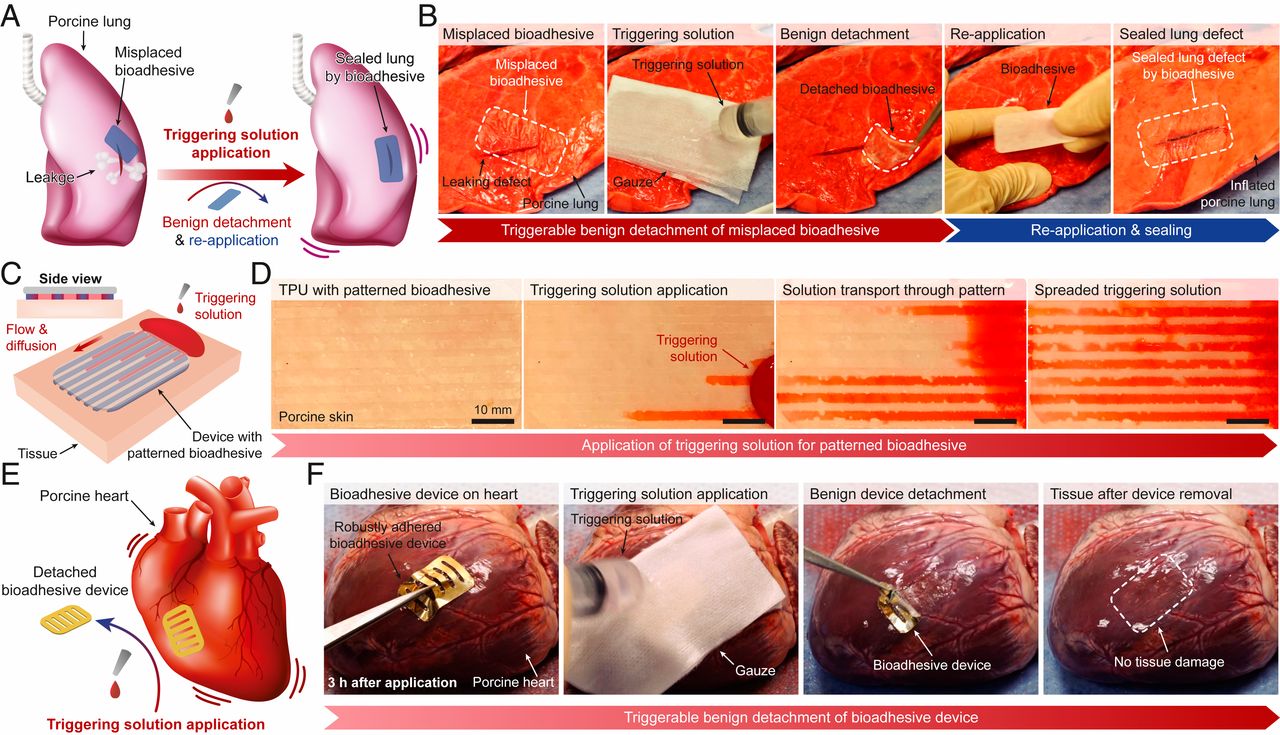[GT] 젖고 미끄러운 장기에도 사용할 수 있는 탈부착 테이프 개발
| 2019년, MIT 엔지니어들이 생물학적 조직과 같은 젖은 표면에 빠르고 단단하게 부착할 수 있는 양면 접착제를 개발했다. 이들은 이 접착제를 사용하여 몇 초 내에 폐와.. |
[GT] 젖고 미끄러운 장기에도 사용할 수 있는 탈부착 테이프 개발
| 2019년, MIT 엔지니어들이 생물학적 조직과 같은 젖은 표면에 빠르고 단단하게 부착할 수 있는 양면 접착제를 개발했다. 이들은 이 접착제를 사용하여 몇 초 내에 폐와.. |
 |
 |
 |
 |
 |
 |

What new technologies will dramatically transform your world? We’ll present an exclusive preview of the stunning breakthroughs emerging from the world’s leading research labs.
**
In 2019, MIT engineers developed a double-sided adhesive that can quickly and firmly stick to wet surfaces such as biological tissues. They showed that the tape could be used to seal up rips and tears in the lungs and intestines within seconds or to affix implants and other medical devices to the surfaces of organs such as the heart.
In considering designs for their original adhesive, the researchers quickly realized that it is extremely difficult for tape to stick to wet surfaces, as the thin layer of water lubricates and prevents most adhesives from taking hold.
To get around a tissue’s natural slipperiness, the team designed their original adhesive out of biocompatible polymers including polyacrylic acid, a highly absorbent material commonly used in diapers and pharmaceuticals that soaks up water, then quickly forms weak hydrogen bonds with the tissue’s surface. To reinforce these bonds, the researchers embedded the material with NHS esters, chemical groups that form stronger, longer-lasting bonds with proteins on a tissue’s surface.
While these chemical bonds gave the tape its ultra-strong grip, they were also difficult to break, and the team found that detaching the tape from tissue was a messy, potentially harmful task.
Removing the tape could potentially create more of an inflammatory response in tissue and prolong healing. It’s a very practical problem.
Now they have further refined the adhesive so that it can be detached from the underlying tissue without causing any damage. In case it needs to be adjusted during surgery or removed once the tissue has healed, the new version can be peeled away like a slippery gel, after applying a liquid solution.
It’s like a painless Band-Aid for internal organs. You put the adhesive on, and if for any reason you want to take it off, you can do so on-demand, without pain.
The team’s new design is detailed in a paper just published in the Proceedings of the National Academy of Sciences.
To make the adhesive detachable, the team first tweaked the adhesive itself. To the original material, they added a new disulfide linker molecule, which can be placed between covalent bonds with a tissue’s surface proteins. The team chose to synthesize this particular molecule because its bonds, while strong, can be easily severed if exposed to a particular reducing agent.
In all their tests, regardless of how long the adhesive had been applied to the tissue, the researchers found that, once they sprayed the triggering solution onto the tape, they were able to peel the tape away from the tissue within about five minutes, without causing tissue damage.
That’s about the time it takes for the solution to diffuse through the tape to the surface where the tape meets the tissue. At that point, the solution converts this extremely sticky adhesive to just a layer of slippery gel that you can easily peel off.
The team hopes that someday, operating rooms can have dispensers of these adhesives, alongside bottles of triggering solution. Then, surgeons can use this like Scotch tape, applying, detaching, and reapplying it on demand.
References
Proceedings of the National Academy of Sciences, June 23, 2020, “Instant Tough Bioadhesive with Triggerable Benign Detachment,” by Xiaoyu Chen, et al. © 2020 National Academy of Sciences. All rights reserved
To view or purchase this article, please visit:
https://www.pnas.org/content/117/27/15497

어떤 신기술이 세상을 극적으로 변화시킬까? 세계 최고의 연구소에서 나오는 놀라운 혁신을 독점 소개합니다.

2019년, MIT 엔지니어들이 생물학적 조직과 같은 젖은 표면에 빠르고 단단하게 부착할 수 있는 양면 접착제를 개발했다. 이들은 이 접착제를 사용하여 몇 초 내에 폐와 내장의 찢어짐이나 구멍을 막거나 심장과 같은 장기의 표면에 임플란트 및 기타 의료 기기를 부착할 수 있음을 보여줬다.
원래 접착제의 디자인을 고려하면서 연구원들은 젖은 표면에는 접착제를 부착하기가 극도로 어렵고, 접착이 된다 하더라도 접착력 유지가 되지 않는다는 점을 알았다.
조직의 자연적인 미끄러움을 해결하기 위해 연구원들은 기저귀와 의약품에 일반적으로 사용되는 흡수성이 높은 물질인 폴리 아크릴산을 포함한 생체 적합성 폴리머로부터 고유의 접착력을 설계하였다. 이러한 기저귀와 의약품은 수분을 흡수한 후 조직 표면과 약한 수소 결합을 빠르게 형성한다. 이러한 결합을 강화하기 위해 연구팀은 해당 물질에 조직 표면의 단백질과 더 강하고 오래 지속되는 결합을 형성하는 화학물 NHS 에스테르를 첨가했다.

이러한 화학적 결합은 접착제에 매우 강력한 접착 능력을 줬다. 하지만 떼어내기가 어려웠다. 그리고 조직에서 접착제를 떼어내는 작업이 지저분하여 잠재적으로 해로운 일임을 알게 되었다.
접착제를 제거하면 잠재적으로 조직에 더 많은 염증 반응을 일으키고 치료에 더 많은 시간이 소요될 수 있다. 이는 매우 현실적인 문제이다.
그래서 연구팀은 조직에 어떤 손상도 일으키지 않고 기본 조직에서 분리될 수 있도록 잡착제를 더 정제하는 연구에 착수했다. 수술 중 조정이 필요하거나 조직이 치유된 후 접착제를 제거해야하는 경우, 이들이 연구한 새로운 버전은 액체 용액을 도포한 후 미끄러운 젤처럼 벗겨낼 수 있었다.
이것은 내부 장기를 위한 통증없는 반창고와 같다. 접착제를 바르고 어떤 이유로든 벗기고 싶다면 필요에 따라 토증을 유발하지 않고 이를 수행할 수 있다.

연구팀의 이 새로운 연구는 국립 과학 아카데미 회보(the Proceedings of the National Academy of Sciences)에 게시된 논문에 자세히 설명되어 있다.
접착제를 분리 할 수 있도록 팀은 먼저 접착 자체를 조정했다. 원래의 물질에 새로운 이황화 링커 분자를 추가했는데, 이는 조직의 표면 단백질과 공유 결합 사이에 배치될 수 있다. 연구팀은 이 특정 분자의 결합이 강하지만 특정 환원제에 노출되면 쉽게 분리될 수 있기 때문에 이 특정 분자를 합성하기로 결정했다.
모든 테스트에서 접착제가 조직에 얼마나 오래 도포되었는지에 관계없이 연구원들은 일단 트리거링 용액을 접착제에 뿌렸을 때 약 5분 이내에 조직에서 접착제를 벗겨낼 수 있다는 것을 발견했다. 물론 조직에는 어떤 손상도 유발하지 않았다.
용액이 테이프를 통해 테이프가 조직과 만나는 표면으로 확산되는 데 걸리는 시간이 지나면, 그 시점부터 용액은 이 극도로 끈적끈적한 접착제를 쉽게 벗겨 낼 수 있는 미끄러운 젤 층으로 변환된다.
연구팀은 언젠가 수술실에 트리거링 솔루션 장치와 함께 이러한 접착제 제거기가 설치되기를 희망한다. 그런 다음 외과의는 이것을 스카치테이프와 같이 사용하여 필요에 따라 부착 및 분리, 그리고 재부착을 자유자재로 할 수 있을 것이다.
- Proceedings of the National Academy of Sciences, June 23, 2020, “Instant Tough Bioadhesive with Triggerable Benign Detachment,” by Xiaoyu Chen, et al. © 2020 National Academy of Sciences. All rights reserved
- To view or purchase this article, please visit:
https://www.pnas.org/content/117/27/15497
 |
 |